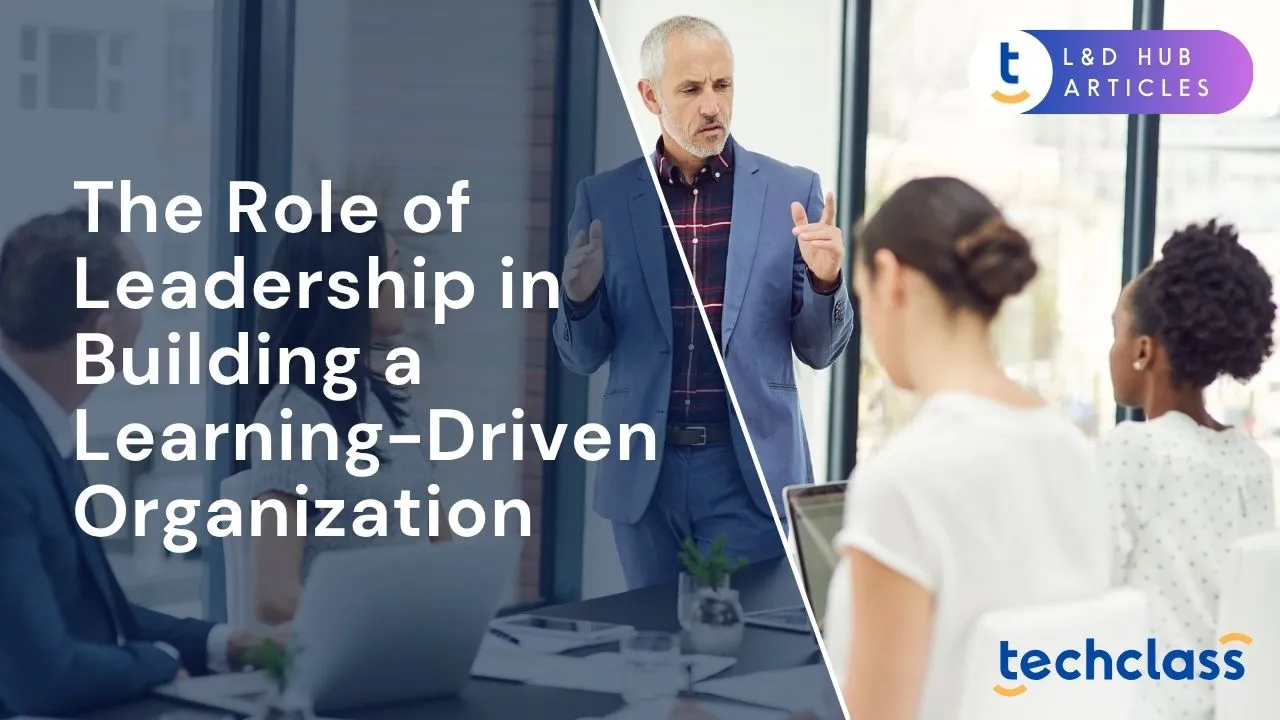
In today’s rapidly changing business environment, continuous learning is no longer a luxury. It is a necessity for organizational survival and success. Companies across industries face disruptive technologies, evolving market demands, and frequent shifts in skill requirements. In response, many organizations are striving to become learning-driven (that is, to embed continuous learning, knowledge sharing, and skill development into their culture).
But what does it take to build such a learning-driven organization? The answer starts at the top. Leadership plays a pivotal role in setting the tone and creating the conditions for a learning culture to flourish.
Effective leaders understand that when employees are constantly learning and improving, the organization becomes more adaptable, innovative, and resilient. In fact, research shows a clear business case for fostering a learning culture. According to LinkedIn’s Workplace Learning Report 2024, companies with a strong learning culture achieved a 57% employee retention rate, more than double the 27% retention at organizations with only a moderate learning culture. Likewise, a Gallup study found that 87% of millennials consider development opportunities essential to their job satisfaction. These statistics underscore that today’s workforce is hungry for growth, and that organizations which prioritize learning gain a competitive advantage in attracting and retaining talent.
Leaders have a unique responsibility and opportunity to champion this culture of continuous learning. This article explores how leadership influences and drives a learning-driven organization. We will define what a learning-driven organization looks like, examine why leadership is the cornerstone of a learning culture, discuss key strategies leaders can use to foster continuous learning, and highlight real-world examples of leadership enabling organizational learning.
In an era of constant disruption, the ability to learn and adapt quickly has become a critical factor for success. Organizations that prioritize continuous learning across all levels are more likely to innovate and respond to changing demands effectively. A strong learning culture also yields benefits like higher employee engagement, better performance, and greater innovation. Conversely, companies that neglect learning risk stagnation and being left behind by more adaptive competitors. Thus, building a learning-driven organization is not just an HR initiative – it is a strategic imperative for long-term competitiveness.
A learning-driven culture is one where learning and knowledge-sharing are embedded into everyday work life. In this environment, individuals continuously seek to improve their skills and share insights, and the organization actively encourages and rewards these behaviors. Mistakes and failures are treated as opportunities to learn rather than causes for blame, fostering a climate of trust. Employees feel safe to ask questions and try new approaches without fear of punishment. Additionally, systems like training programs, mentoring, and knowledge-sharing platforms are in place to support ongoing development. Together, these elements create an ecosystem where growth is part of the company’s DNA.
Leaders have an outsized influence on whether a learning culture takes root. Employees pay attention to what their leaders do and reward. If executives and managers actively champion learning – by investing in development, talking about growth, and participating in training themselves – it sends a powerful signal that continuous improvement is valued. On the other hand, if leadership ignores development or penalizes mistakes, employees will stick to the status quo and avoid risks. Leaders also shape formal policies to integrate learning into the organization. For example, they can include learning goals in performance reviews or tie promotions to the acquisition of new skills. Finally, leaders set the tone in how they respond to setbacks: by treating failures as learning opportunities rather than reasons to blame, they encourage teams to take initiative and innovate. In short, leadership acts as the architect of the company’s learning environment – their priorities and behaviors become the blueprint that others follow.
One of the most powerful ways to build a learning-driven organization is for leaders to lead by example. When those at the top demonstrate curiosity, humility, and a commitment to personal growth, it sets the tone for everyone else. For example, Microsoft CEO Satya Nadella famously shifted his company’s culture from a “know-it-all” mentality to a “learn-it-all” mentality. He encouraged his team and himself to embrace continuous learning and listening, a change widely credited with revitalizing Microsoft’s innovative spirit and performance.
Leading by example also means managers become teachers and coaches. Rather than delegating all training to an L&D department, effective leaders mentor their teams and share knowledge directly. This hands-on approach develops employees’ skills and also reinforces that learning is a priority. Research has found that when leaders regularly teach and coach their employees, those teams gain stronger problem-solving abilities and higher motivation. By being visible learners and mentors, leaders inspire their people to keep learning as part of everyday work.
Leadership should start by clearly articulating why continuous learning matters for the organization’s future. By tying employee development to the company’s mission and goals, leaders give purpose to learning efforts. When people understand how building new skills will help the organization innovate or compete, they become more motivated to learn. Leaders must frequently reinforce the message that “our company succeeds when our people grow.”
A learning culture thrives in an atmosphere of trust. Leaders need to make it safe for employees to ask questions, admit mistakes, and experiment with new ideas. This means no blaming or punishing team members when something doesn’t work out. Instead, managers should encourage open discussions about what went wrong and what can be learned. By showing empathy and focusing on solutions (rather than placing blame), leaders create psychological safety. In this environment, people are far more willing to take initiative, share ideas, and learn from each other, exactly the behaviors that drive innovation.
Leaders must back up their words with resources. Building a learning-driven organization requires investing time and money in employee development. This could mean budgeting for training programs, workshops, or online courses – and just as importantly, allowing employees time during work to focus on learning new skills. If people are expected to learn on their own time without support, it likely won’t happen. Providing tools such as e-learning platforms or access to industry conferences, and carving out dedicated learning hours, demonstrates that the company truly considers learning part of the job. This tangible support empowers employees to pursue growth without feeling that development is a secondary priority.
Leaders should encourage employees not only to learn for themselves but also to share their knowledge with others. A culture of knowledge sharing can be fostered by setting up forums for employees to exchange ideas – for example, internal “lunch and learn” sessions, cross-team workshops, or online communities where people post tips and insights. Mentoring programs are another effective tool: pairing experienced employees with those eager to learn (or even reverse mentoring, where junior staff teach senior leaders about new trends) spreads expertise throughout the organization. When leadership participates in and recognizes these knowledge-sharing activities, it reinforces the message that everyone should learn together and learn from each other.
Finally, leaders need to acknowledge and reward learning. People tend to repeat behaviors that get recognized. Therefore, celebrating employees who pursue development sends a clear message to everyone else. Managers can give shout-outs in meetings or newsletters to team members who have learned new skills or improved processes. Some organizations even include learning milestones as part of performance evaluations or offer promotions and new opportunities to those who continually grow. By tying positive recognition and career advancement to learning, leaders create a strong incentive for employees to keep expanding their abilities. Over time, this makes continuous learning the norm – as people see that growing their skills is not only encouraged but also beneficial for their careers.
It’s helpful to see how these principles play out in practice:
Building a learning-driven organization is an ongoing journey that requires strong leadership at the helm. The business environment will keep changing, so companies must be ready to adapt by continually developing new skills and knowledge. Leaders are the linchpin of this adaptability. By consistently championing learning, through their vision, actions, and decisions – they ensure that their organizations stay curious, resilient, and innovative. In essence, leadership must treat learning as a strategic priority. When they do so, the organization gains a workforce that is equipped to navigate change and drive long-term success. In a world where the only constant is change, an organization that learns continuously will always find a way to thrive.
Leadership sets the tone, creates the culture, and influences behaviors that foster continuous learning and knowledge sharing among employees.
Leaders can lead by example by embracing curiosity, humility, and ongoing personal development, showing their teams that learning is a priority.
Leaders should communicate a vision for growth, create a safe space for innovation, invest in resources, encourage knowledge sharing, and recognize learning efforts.
Psychological safety encourages employees to ask questions, admit mistakes, and experiment without fear of blame, which fuels innovation and continuous improvement.
Examples include Satya Nadella transforming Microsoft’s culture into a learning organization and AT&T investing heavily in employee reskilling to stay competitive.


.webp)